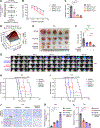Metabolic regulation of the glioblastoma stem cell epitranscriptome by malate dehydrogenase 2
- PMID: 39454581
- PMCID: PMC11726586
- DOI: 10.1016/j.cmet.2024.09.014
Metabolic regulation of the glioblastoma stem cell epitranscriptome by malate dehydrogenase 2
Abstract
Tumors reprogram their metabolism to generate complex neoplastic ecosystems. Here, we demonstrate that glioblastoma (GBM) stem cells (GSCs) display elevated activity of the malate-aspartate shuttle (MAS) and expression of malate dehydrogenase 2 (MDH2). Genetic and pharmacologic targeting of MDH2 attenuated GSC proliferation, self-renewal, and in vivo tumor growth, partially rescued by aspartate. Targeting MDH2 induced accumulation of alpha-ketoglutarate (αKG), a critical co-factor for dioxygenases, including the N6-methyladenosine (m6A) RNA demethylase AlkB homolog 5, RNA demethylase (ALKBH5). Forced expression of MDH2 increased m6A levels and inhibited ALKBH5 activity, both rescued by αKG supplementation. Reciprocally, targeting MDH2 reduced global m6A levels with platelet-derived growth factor receptor-β (PDGFRβ) as a regulated transcript. Pharmacological inhibition of MDH2 in GSCs augmented efficacy of dasatinib, an orally bioavailable multi-kinase inhibitor, including PDGFRβ. Collectively, stem-like tumor cells reprogram their metabolism to induce changes in their epitranscriptomes and reveal possible therapeutic paradigms.
Keywords: ALKBH5; MDH2; PDGFRβ; alpha-ketoglutarate; cancer stem cell; epitranscriptomics; glioblastoma; m6A; malate-aspartate shuttle; metabolism.
Copyright © 2024 Elsevier Inc. All rights reserved.
Conflict of interest statement
Declaration of interests The authors declare no competing interests.
Figures







References
MeSH terms
Substances
Grants and funding
LinkOut - more resources
Full Text Sources
Molecular Biology Databases
Research Materials
Miscellaneous

